The Keukenhof – Holland’s Incredible Botanical Gardens
In the previous post we finally got underway on our bike and barge tour of Holland with Cycletours. We boarded the Zwaan in Amsterdam and made our way to the city of Haarlem where we moored for the night. Today we are going to visit the Keukenhof gardens at the height of spring bulb season. It is has been a lifelong dream of mine to see this place and it’s finally going to happen. Please join Alison and me on the tour.
The day dawns bright and sunny with this sunrise over Haarlem as I continue my habit of getting up very early to catch up on my office work, the writing of this blog and then to walk as much as I can before breakfast. The Zwaan has wifi, but it is slow when multiple users are trying to access it so from six thirty to seven thirty I pretty well have it to myself.
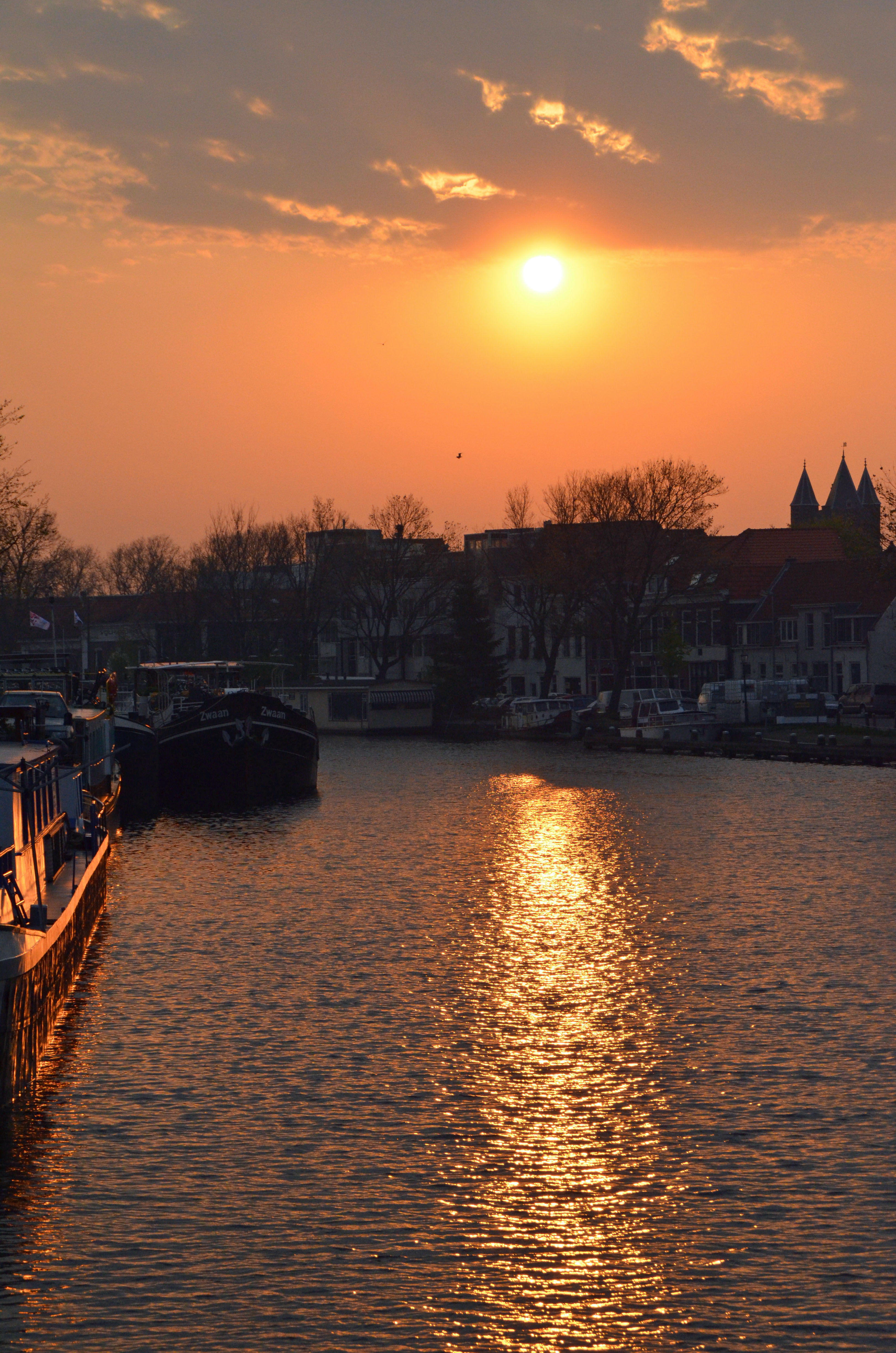
Heading out for a stroll with Alison we noticed these unusual looking geese doing what looked like their version of morning stretch exercises.
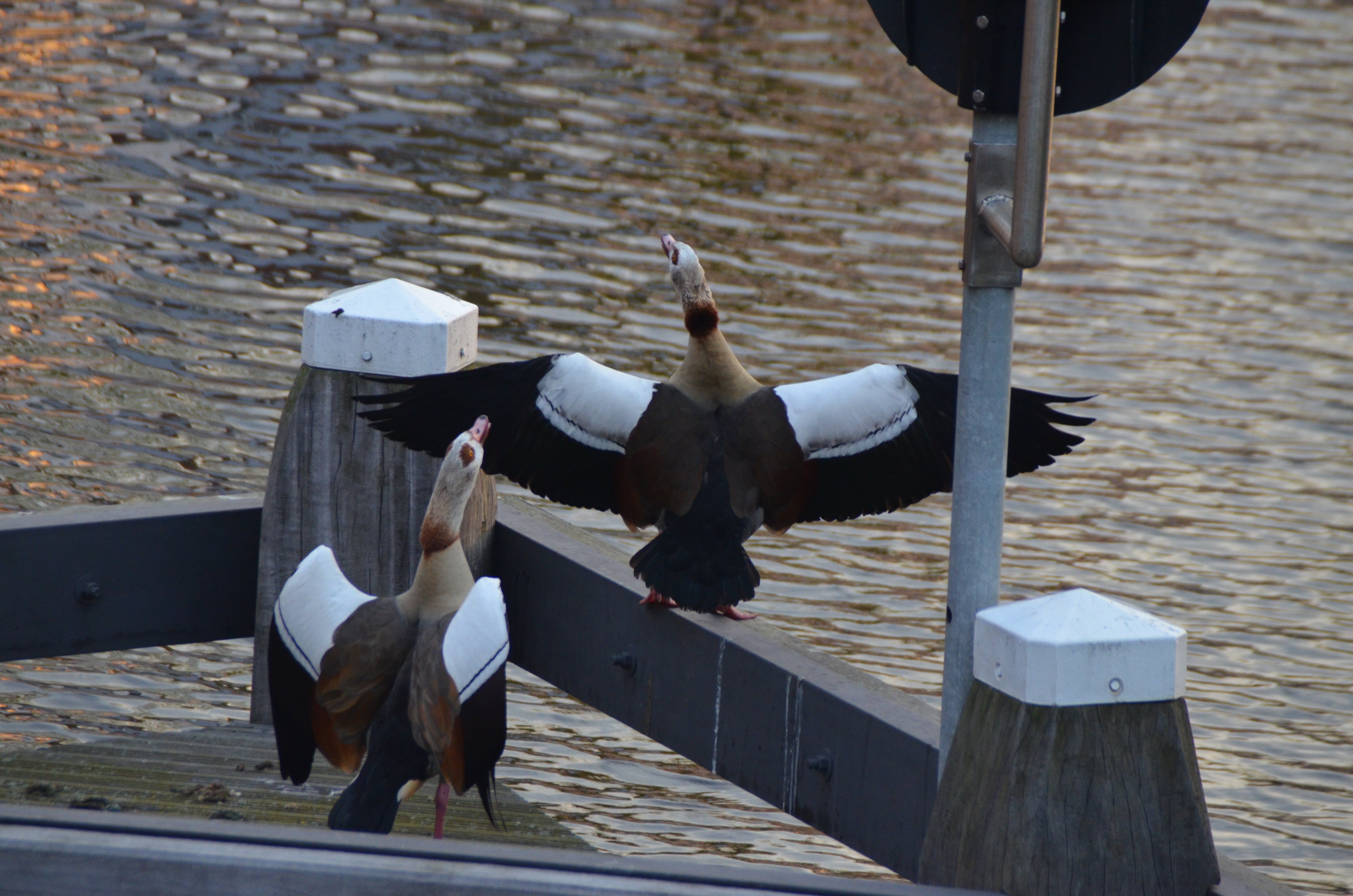
The Grote Kerk looked especially alluring without the hoards of people that were out and about the night before.
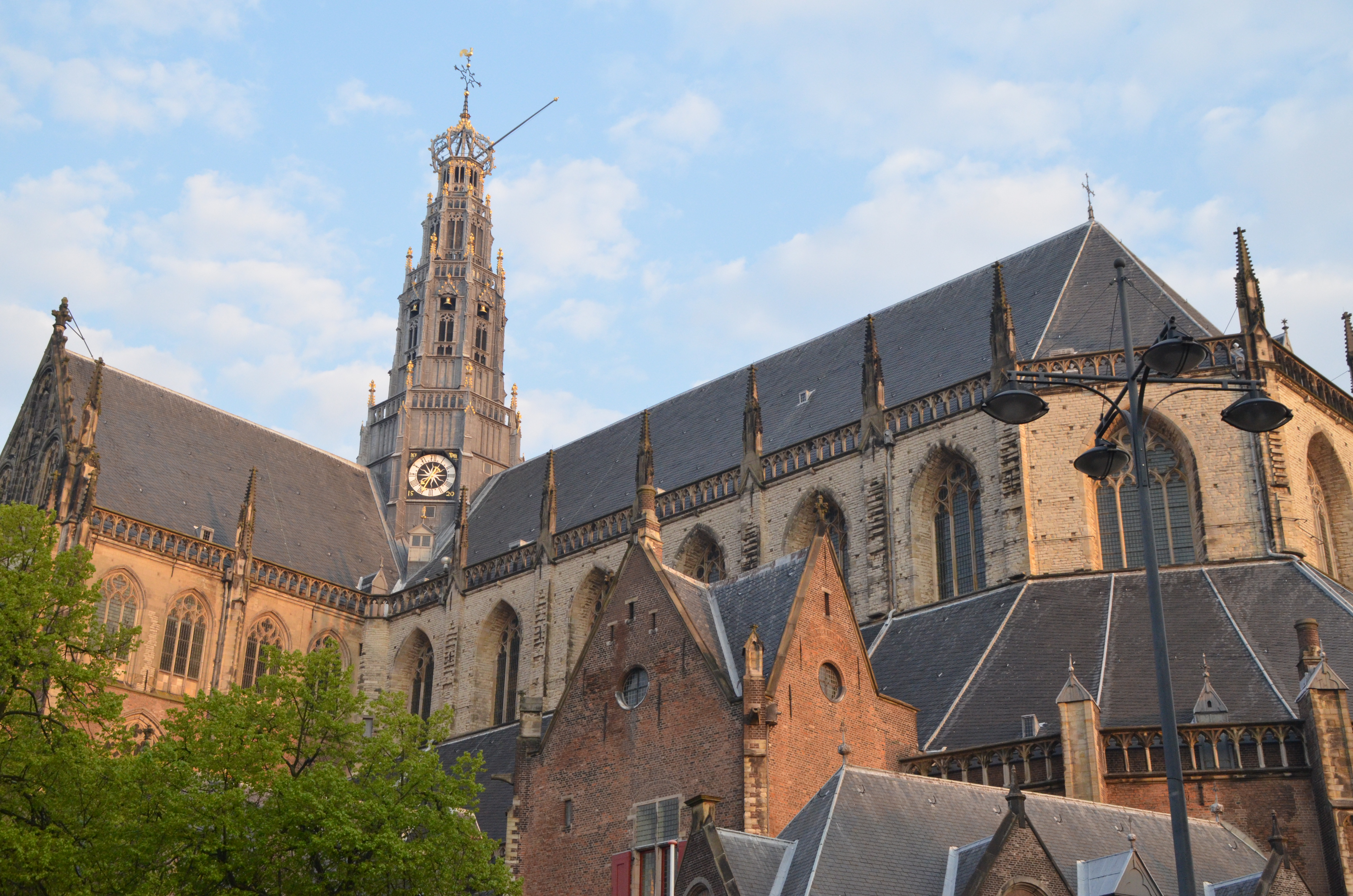
Focusing on the upcoming visit to the Keukenhof, I had completely forgotten that it was Easter Sunday morning until we got back to the boat and saw the community dining table decked out like this. Marije brought out fresh brewed coffee and hot water for tea at seven, while breakfast was served punctually at eight.
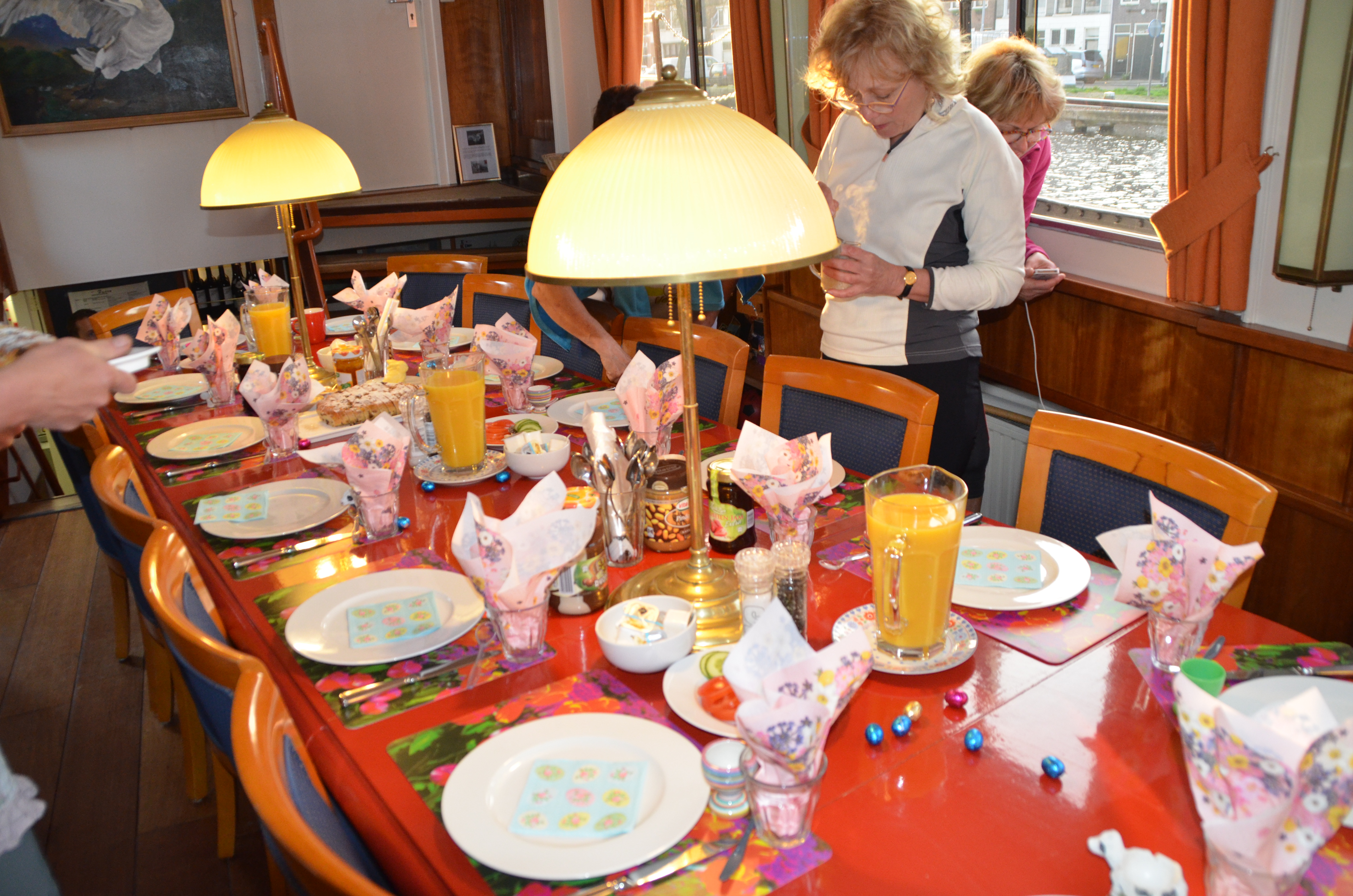
Dorus prepared a special breakfast with each guest getting an egg cup and a warm soft boiled egg to break and spread over freshly baked Easter rolls. I can’t remember the last time I used an egg cup. On the sideboard there was a good selection of cereals, yogurt and a huge basket of fruit with plums, pears, apples, oranges, bananas, kiwis and grapes that looked like it could have been the model for some of the still lifes we had seen at the Rijksmuseum. Marije then distributed platters with a selection of prepared meats and cheese slices along with several baskets of various types of bread. I have always been a fan of the European habit of enjoying meat and cheese for breakfast. We also used these to prepare sandwiches which, along with the fruit and a selection of crackers and biscuits, would be our lunch.
Departure time from the boat was scheduled for nine and to his credit Albert got everybody ready by then and explained the plan of attack for the day, first in French and then in English. We would take a short tour in Haarlem after which we would leave the city and pedal to the Keukenhof for a two hour visit.
Haarlem was very quiet and peaceful on this Easter morning and we stopped at a couple of places where the cherry blossoms were so thick that they literally formed a carpet beneath our feet.
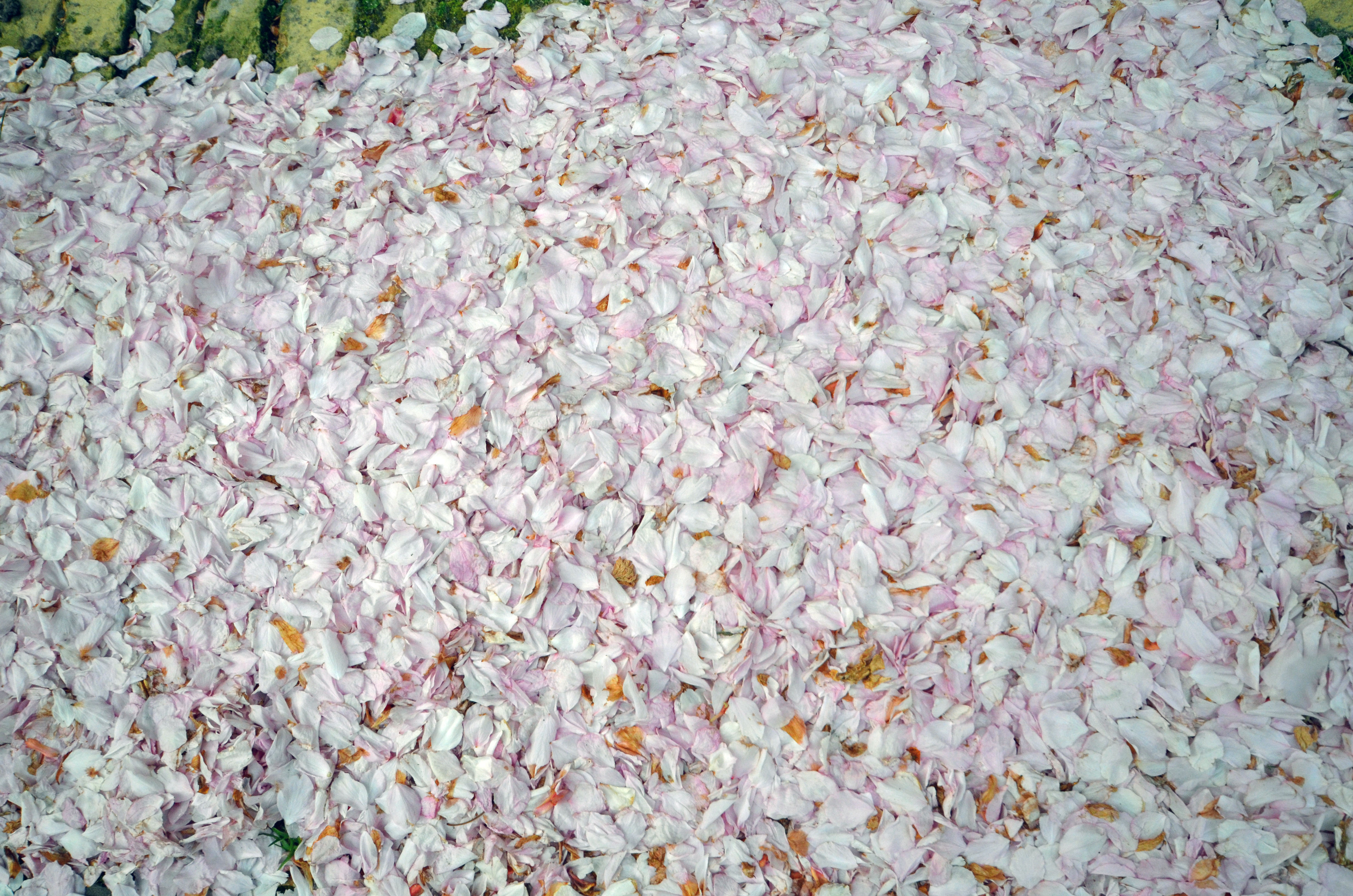
Albert took us to an ancient gated courtyard that contained a number of small buildings that were too small to be called houses, but certainly were dwellings of a sort. He explained that this was Hofjes van Bakenes, a traditional almshouse for women that dated back to 1395. Due to the wars, plagues and other pleasantries that comprised medieval life many poor women found themselves widowed and destitute, often at a very young age. In this area of Holland, and in particular Haarlem, it became customary for wealthy patrons to build these hofjes to house these women who lived together communally, sharing gardens and living space. The tradition survives to the present day with nineteen hofjes still in existence in Haarlem. While we were being rude and staring unabashedly through the gates a well dressed and healthy looking young woman came out from one of the doors and apparently used to gawking tourists, went about her business as if we were not there.
So that’s how they treat persons who have fallen on hard times in Haarlem. I couldn’t help but think that we had not seen a single street person in Amsterdam. No beggars, loiterers, hustlers, hasslers or pan handlers. No gypsies either. When I asked Albert about why not he replied ” We just give them a place to live”. That might be a bit altruistic, but the Dutch have apparently solved a problem that is becoming endemic in North America. In my city of Halifax you cannot walk down the main shopping street without being accosted by people who are obviously mentally ill, addicts or just plain bums – it is not a pleasant experience and must be very off-putting for tourists. I don’t know what the answer is, but maybe we could send some city Councillors to Haarlem to look for a solution.
I hardly had the chance to reflect on the many sites in Haarlem that we did not get a chance to visit including the Frans Hals Musuem and the Teylers Museum when almost without noticing it we were suddenly in the countryside. The transition between urban and rural in Holland is almost instantaneous in some places – no miles of interminable suburbs, strip malls and car dealerships. And oh, what a countryside! We have all heard the expression “God’s country”. Well I think if there was a God he very well might have chosen as his favoured landscape the area between Haarlem and the hamlet of Cruquius. I cannot recall ever seeing a better meld of the man made and the natural into one harmonious landscape. Keeping in mind that virtually every aspect of the Dutch landscape has been altered by man, then perhaps he should get the credit for doing something right for once.
The one real downside of taking a guided cycling tour is that you cannot stop whenever you want. It was Albert’s job to get us to the Keukenhof on time so tarrying for pictures was not on the agenda. That leaves my limited descriptive abilities to fill in where a photo cannot. On the right side of the small elevated road we traveled was a scene right out of a John Constable painting – huge willow trees on the banks of the River Spaarn with wildflowers interspersed with the green grass upon which lowing cattle grazed contentedly. The sounds of the birds was incredibly diverse and even loud. It reminded me of the sounds parrots make and then I looked up and somewhat disbelievingly saw a flock of parrots. Albert confirmed that there were flocks of escaped parrots that had successfully made the Haarlem countryside their home.
On the left side were impossibly tidy gardens overflowing with flowering bulbs of all types and colours. The houses, while certainly not mansions were quite large and all well maintained – no chipping paint, rusting drainpipes or crumbling bricks. Every house had its own style as if there had been an architectural competition to see who could design the most comfortable looking house that fit in with the landscape. Nothing ultramodern or oversized or out of place. Most houses had a dog, many had chickens and a few had children sized ponies. I couldn’t help thinking – “I wish I could live there!” at almost every house we passed.
We did finally stop in front of one place that had a huge collection of farm implements in the large lot along with two very curious llamas that rushed up to stare at us. One of the Frenchman caused riotous laughter among his colleagues when he spit at the llamas before they could spit at him.
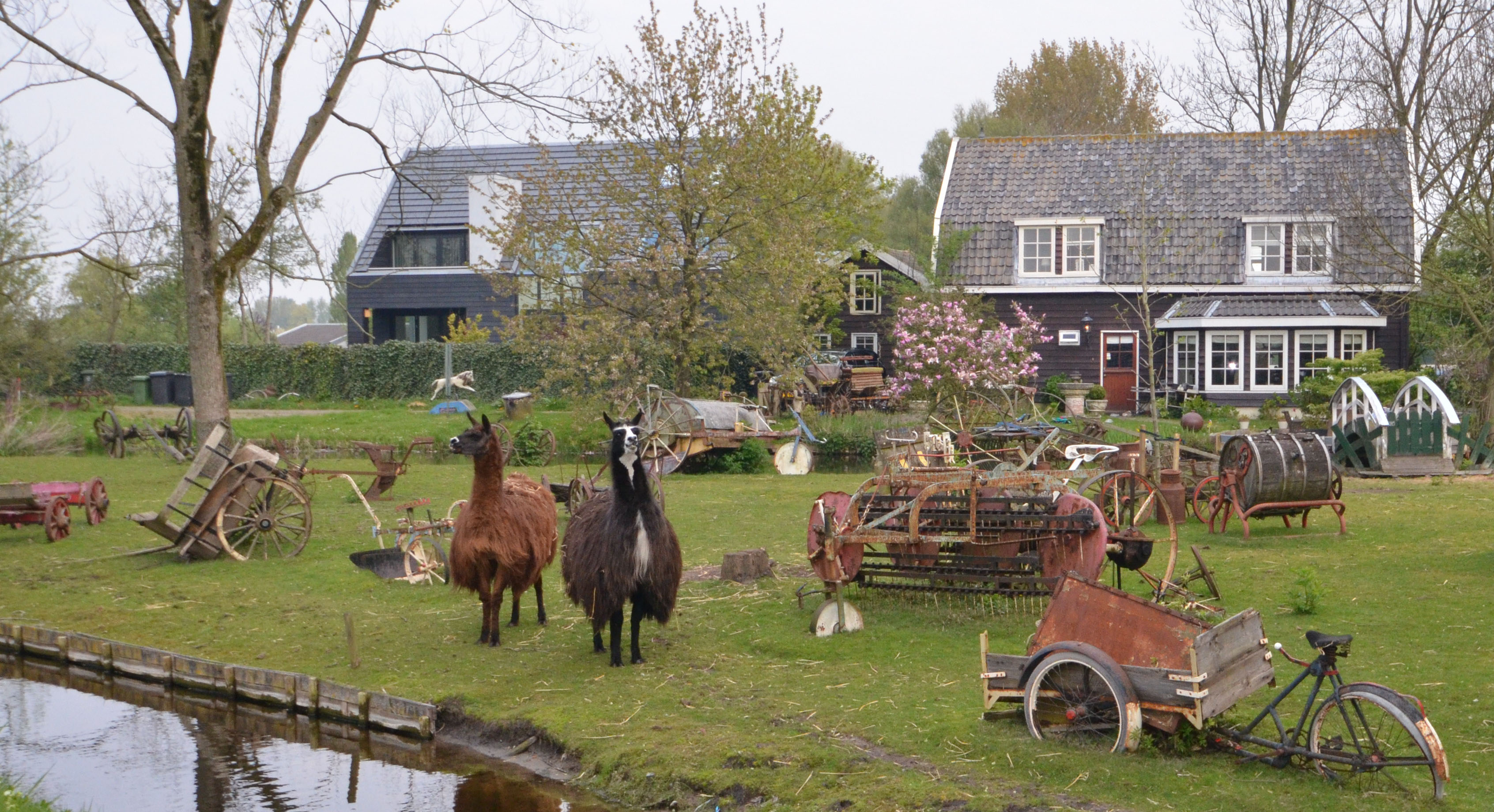
Not long after visiting the llamas we left the last of the houses behind and broke into open country with green fields on all sides. There was a noticeable difference between the fields on our right side and those on our left. Those on the right were almost on the same level as the road and those on the left considerably lower. It had been apparent to me for some time that the road we were traveling on sat atop a dyke and in fact in the Dutch countryside dykes make a perfect spot to put a road, thus killing the proverbial two birds with one stone – a transport route and water management.
The fields on our left were actually below sea level and were the first examples we came across of land reclaimed by the Dutch through the polder system. I don’t mean to be overly preachy, but you can’t understand Holland without understanding the never ending battle with the sea and the need for the Dutch to create new land for an expanding population. Just about every other country that needed extra space or Lebensraum as the Nazis called it, gained it by invading a neighbour. Not so the Dutch – they made it and I was now looking at a prime acreage of former seabed.
Since water tends to obey the laws of gravity and migrate to the lowest space possible, it’s not enough to just throw up a dyke and wait for Mother nature to dry the land out for you. You need pumps and that’s where the windmills come in – they are actually the world’s most photogenic pumps. But I digress, there is not a windmill in sight.
What there is, however, is only the world’s largest steam powered machine. Right here in this little place called Cruquius is this gigantic mechanical marvel that makes every engineer’s must see list. It was built in the 1800’s as a sort of super device that could drain as much water as who knows how many windmills. It reminds me of the Walt Disney cartoon about Paul Bunyan and his blue ox Babe and their contest with the men with saws and a train, to see who could cut and stack the most wood. Paul and Babe lost by a quarter of an inch and walked dejectedly off into the wilderness. I bawled my eyes out when I first saw that at as a kid – it just wasn’t right that the green technology of an axe and an ox should lose out to a bunch of dweebs with a steam engine.
I’m glad to report that in Holland things have a happier ending. Mr. Cruquius steam engine is now a museum and the windmills continue to do the same proficient job they have been doing for hundreds of years. I think you will agree that while the steam engine building is quite handsome, it is no windmill.

We pushed on towards the Keukenhof and after about an hour we came across our first bulb fields. This is a moment and a sight I don’t think I’ll ever forget. For my entire life I have been conditioned to think of fields as green or in harvest season yellow, maybe even golden yellow. But nothing can prepare you for the first time you see fields that are bright red, orange, mauve, white or even parti-coloured. It’s like some kind of mental restraint has been lifted on the abstract idea of ‘field’ and suddenly your mind’s eye is free to visualize ‘field’ as anything and any colour you want it to be.
While all of us in the group whined insistently about wanting to stop, Albert dismissively said “There is better ahead” in what I swear was a deliberate Arnold Schwarzenegger imitation. He was right of course. Not a mile later we came across a field of bulbs that was just off the road and not blocked by either a canal or a fence. As I’ve learned subsequently, this is very rare.
There was already a Japanese lady taking photos of her two kids, but nobody else in sight. We stopped and couldn’t wait to get the cameras out. As you will see from the photographs the bulbs are planted in rows about four feet wide with plenty of space in between them to pose for photos. There is absolutely no need to actually go into the bulbs and tramp them down and thankfully I didn’t see anyone doing that. To be able to walk among these spectacular blooms is a privilege and it would be a travesty if the few fields that are open to the public became off limits because of the actions of a few idiots. In other words “No, tiptoeing through the tulips”. Anyway here is what greeted us in our first foray into a dutch tulip field.
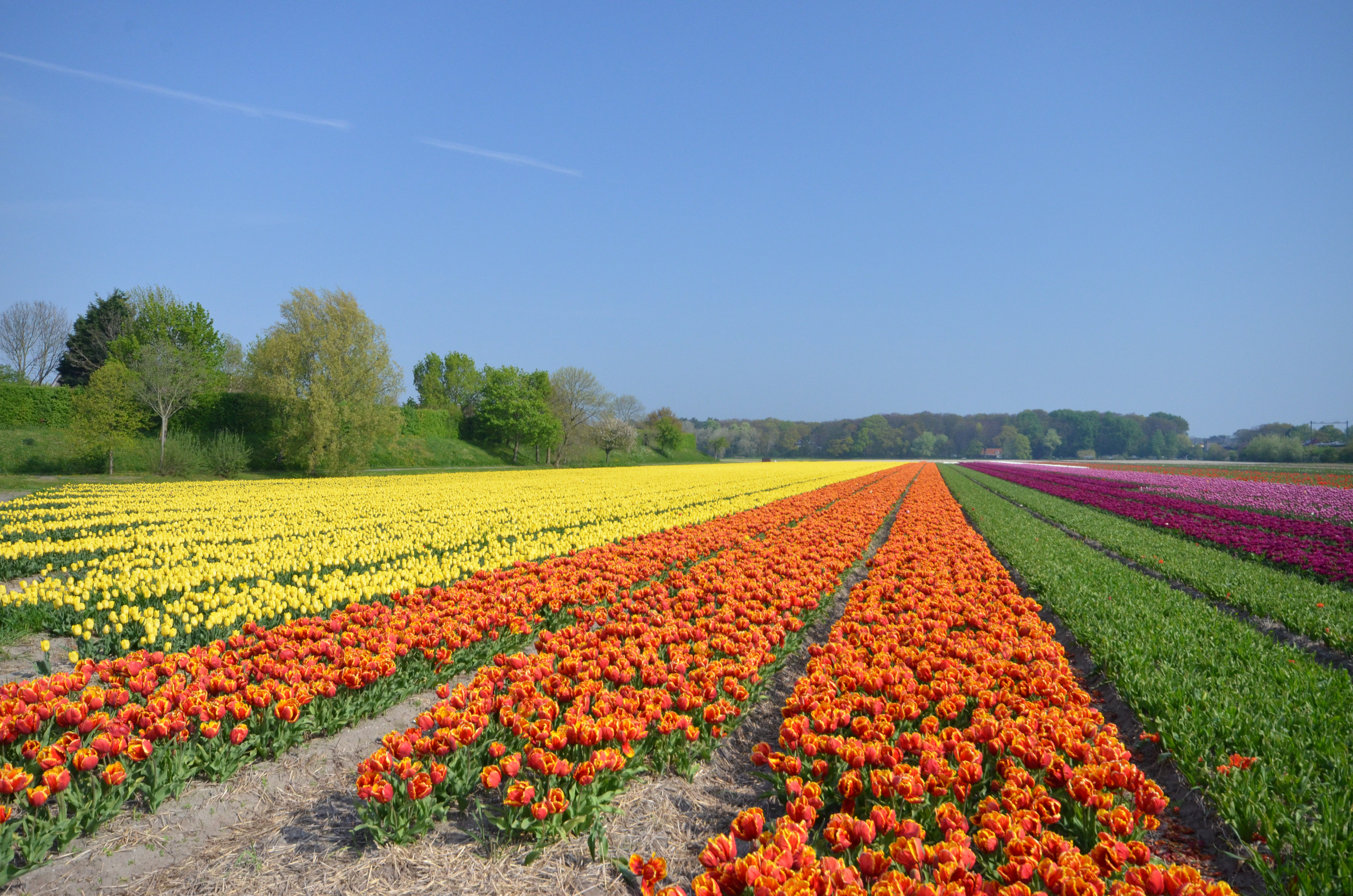
And here I am in it.
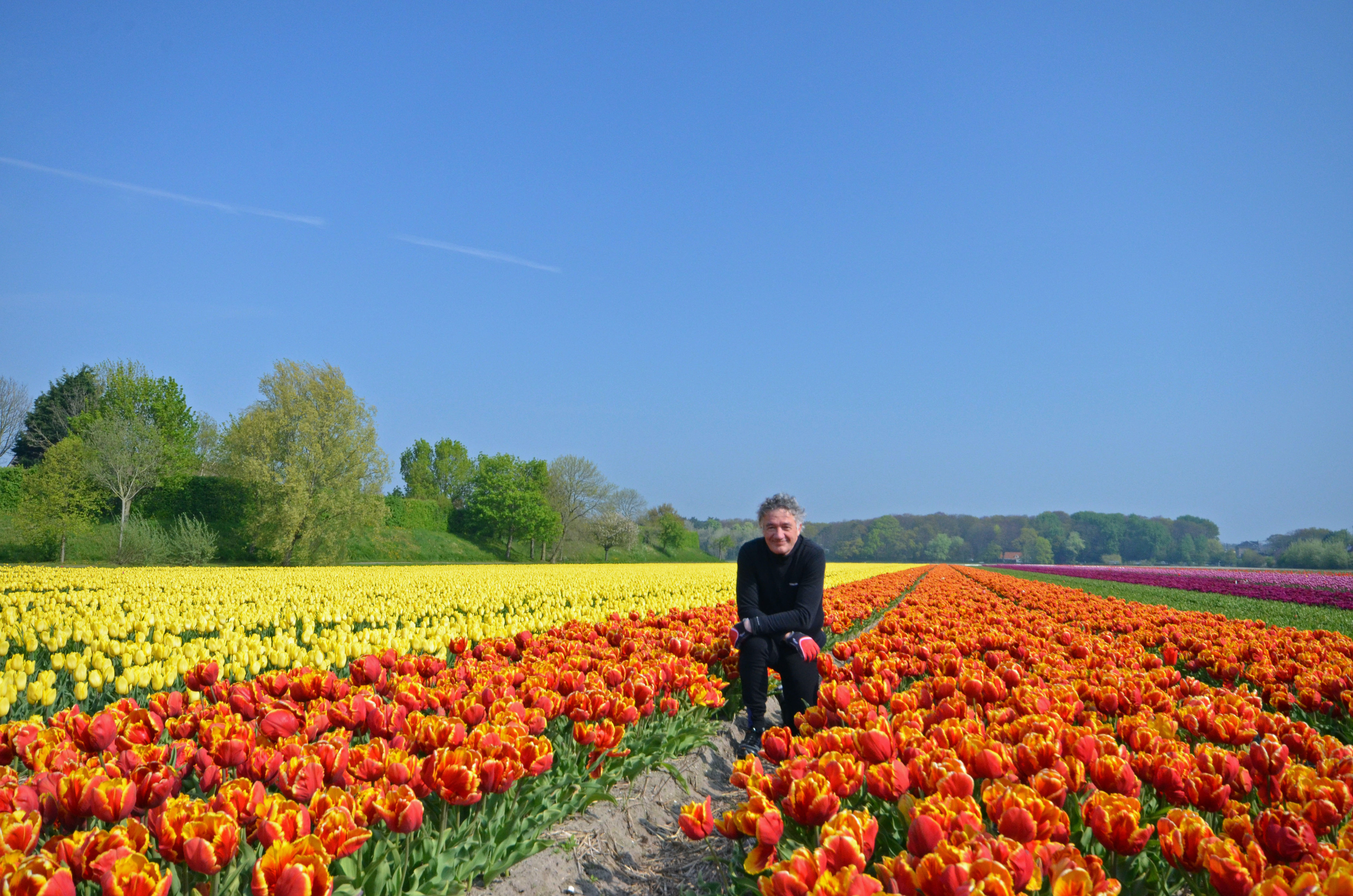
You will notice my interest is purely scientific and not just to get a great shot to use on my next Christmas cards (if I ever sent any). Actually as a gardener I was very surprised to see how sandy the soil was. I was expecting something similar to that on the prairies where it is a dark, rich loam created from the silt that accumulated as the last glaciers retreated and massive Lake Agassiz dried up. But while black soil is great for many food crops, you cannot beat a sandy, well drained soil for bulbs which contain their own nutrients.
Here is another shot of these amazing fields.
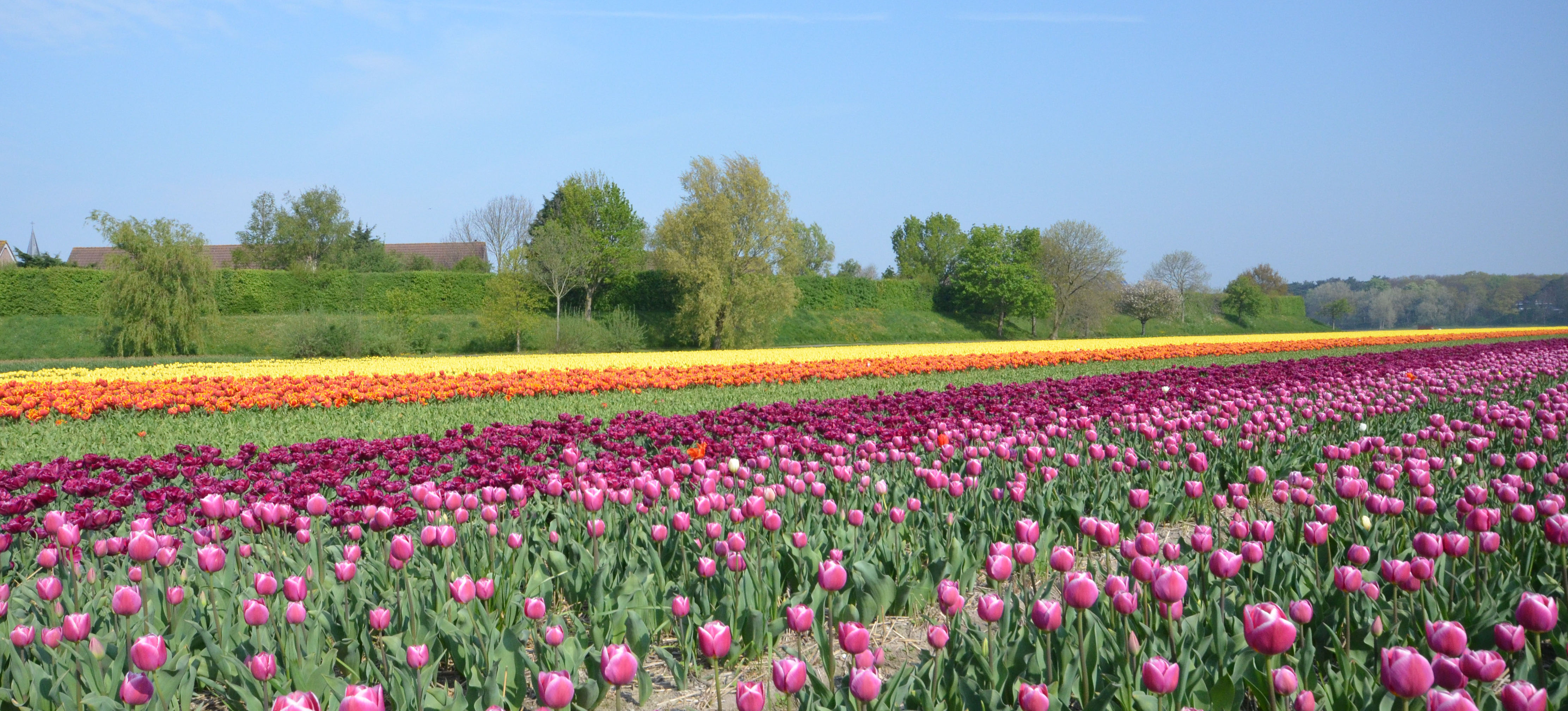
Albert almost had to tear the cameras from everyone’s hands and get us back on the road to the Keukenhof which was not far away. As we approached it was pretty obvious that it was going to be a crowded spot. Individual cars were parked on the side of the road over a mile from the entrance and one bus after another passed us heading the same place we were. Amazingly, because we were on bikes we were able to park them only about a hundred yards from the entrance.
Now here’s something I don’t get about the Dutch considering all their really decent qualities – apparently they steal each other’s bikes like squirrels steal nuts. In the sign up for the trip we were advised to buy theft insurance for the bikes which I believe everyone dutifully did. It turns out the bikes already have a built-in locking mechanism that prevents them from being ridden once it is engaged, but I guess that is just a mere bagatelle to professional thieves who scoff at such precautions. Before leaving that morning Albert gave us each an extra chain and lock which we used for the first time at the Keukenhof.
It was just before noon and Albert gave us all our tickets and said to meet back at the bikes at 2:00. We would have just over two hours to explore this botanical wonderland.
I very much suspect that Sunday April 20th was the busiest day in the history of the Keukenhof gardens. I say this for the following reasons – the weather was fabulous, it was Easter, it was the height of the bulb season that year and who in their right mind would not head to the Keukenhof on such a day. As it turned out, few indeed. I never saw so many people from so many countries all wanting to enjoy the same thing at the same time. Who knew that tourists from India even existed, yet alone loved flowers? How about Iranian and Israeli tourists actually helping to take pictures of each other? Given the number of Chinese, Japanese and South Koreans, I half expected to see Kim Jong-un leading a group of North Koreans armed with ancient Brownie cameras to the entrance.
I think you get the picture – it was f***ing insanely crowded.
So did this ruin the visit for a guy who hates crowds – not a bit. There is something about flowers that have a calming affect on everyone. Alison and I obviously were not the only ones disappointed in the crowds, but we were here for the flowers and so were they.
I am not going to try to describe the Keukenhof other than to say that if you love flowers, and especially bulbs, then you must visit. I saw techniques in use that I will try back home, like using a carpet of muscari underneath tall tulips like triumphs as in this picture.
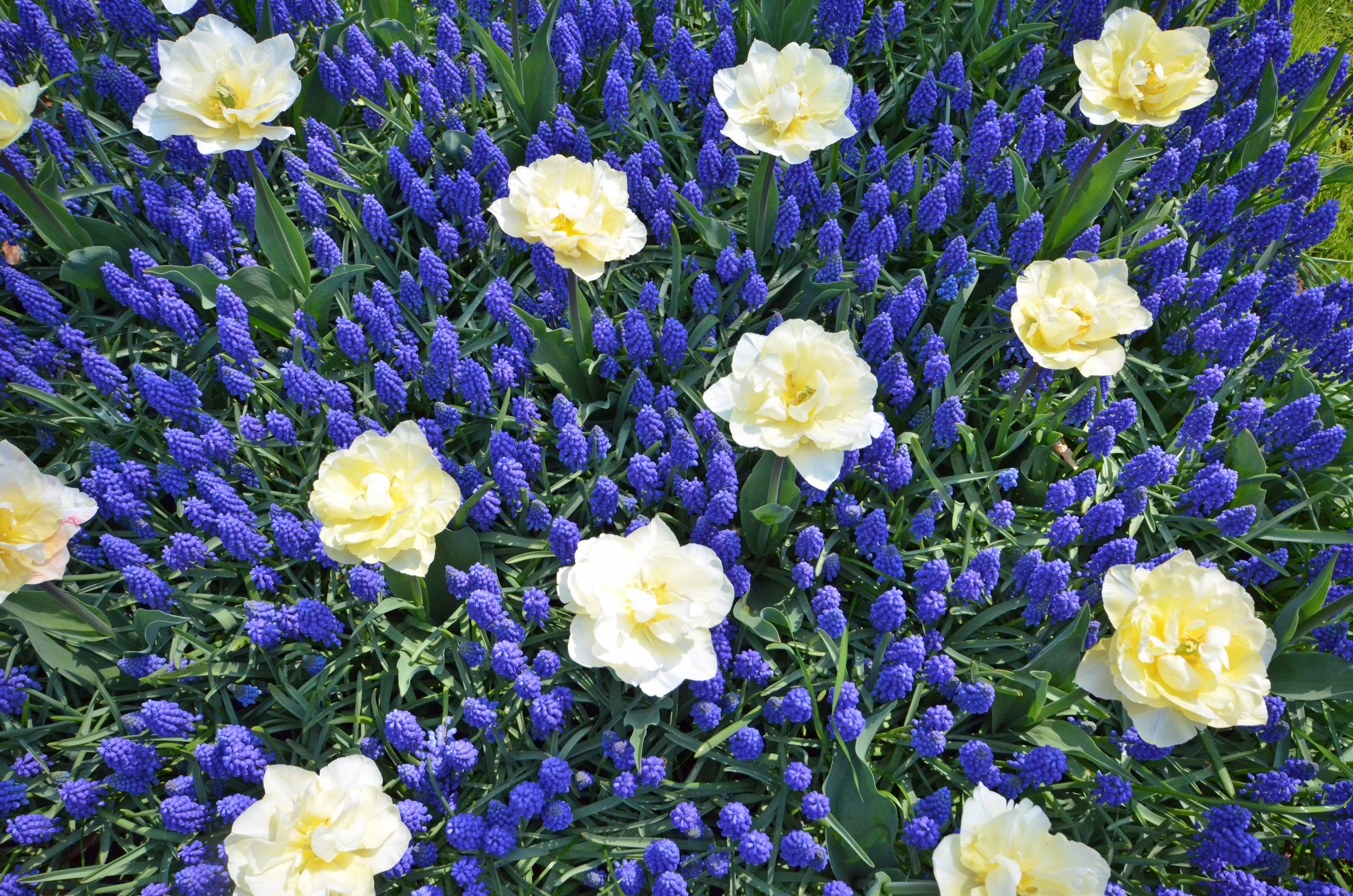
Other techniques used at the Keukenhof like getting bulbs and other flowers that usually bloom a different times to bloom together are beyond my abilities. For example, these fritillaries would never be in bloom the same time as tulips or hyacinths at home.
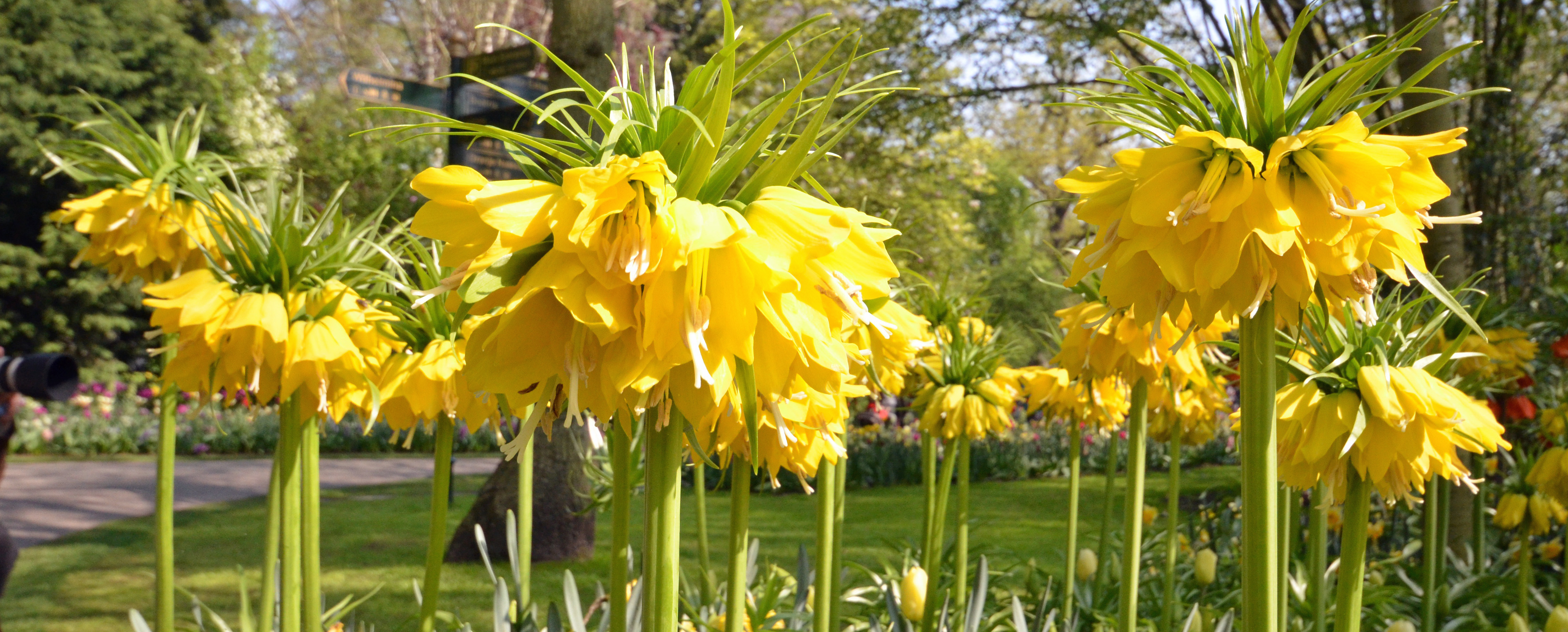
What I have done is create a gallery of Keukenhof photographs and I hope you will enjoy them a fraction as much as I did in seeing them for real.
We ate our lunch seated beneath the shade of a tree beside a small canal that separated the gardens from the miles of bulb fields on the other side.
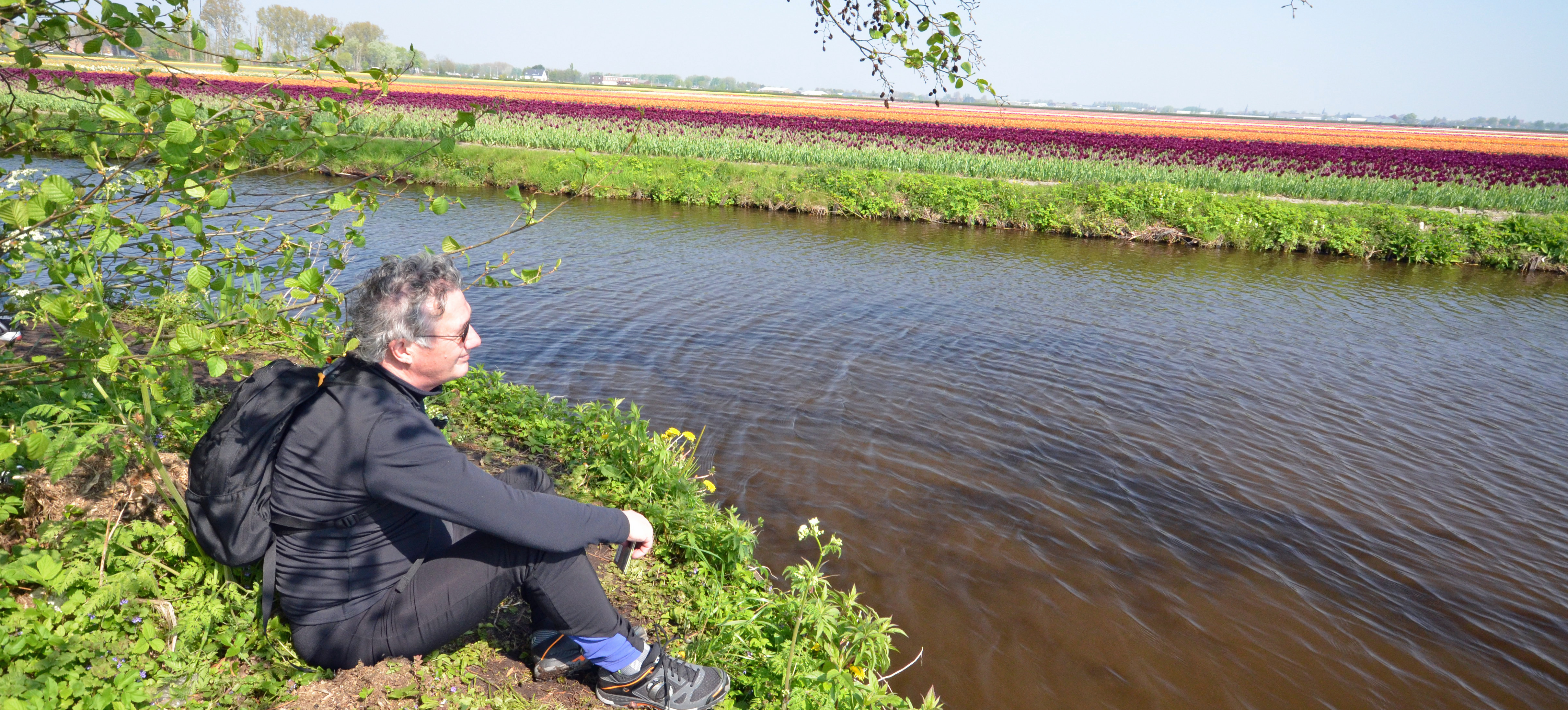
The one thing was not up to par at the Keukenhof were the crappy souvenirs for sale. They all looked like they had just got off the boat from China. I found much better quality Keukenhof related items in shops in Leiden later that day.
Back at the bikes by five to two we joined most of the rest who were already back. By two only one couple, Anike and Andre were missing. They were still missing at quarter after and half past two. Albert finally decided to go looking for them which was a daunting task considering the crowds, however, there was another entrance so they might be there. Sure enough they were. I’m not going to speculate on how the two of them could convince themselves they were in the right place when there were no bikes there and none of the rest of the group, but I just have to wonder how long they would have stayed if Albert had not retrieved them.
Having lost almost an hour we had little time for stopping on the way to the barge which was moored in Leiden some twenty kilometres away. It was a delightful if somewhat hurried ride with many more bulb fields on both sides, although we passed only a few that were accessible from the bike path or road.
Leiden is one of Holland’s oldest cities and the home to one of the first great western universities. The city has always been a leader in liberalism and toleration so I was a bit surprised to see how many Muslim men and women there were on the streets. I can only hope that they were there to adopt western ways and ideas and not to try to stifle the religious freedom for which Leiden is famous.
We took a tour around the inner city canal looking for the Zwaan, but although the other Cycletours’ barges were there, no Zwaan. Albert took us to a pleasant outdoor cafe where I convinced Liz, the Hawaiian grandma, to try a fresh white beer the place had on tap and she loved it – so did I. After a thirty minute stop we made the canal circle again and still no Zwaan. First Anike and Andre and now the Zwaan. What next? Albert then had an inspiration – he called Ilja to see where they were. Turns out the Zwaan was here all along, moored alongside the much large Wending so we could not see it from the city side. We forced our tired legs to get on the bikes one last time and pedal five more minutes to the Zwaan’s secret location. By now everyone was starting to realize that it had been a very tiring day and fatigue set in like a London fog.
We were going to have to get the bikes up and over the Wending and then onto the Zwaan – just what you would feel like doing at this stage of the day – not! Albert asked for two men to stay behind and help him, which I did. When the bikes were ready to be loaded after everyone took away their personal items there was not a Frenchman in sight, just Albert and you know who. We recruited Dorus to help us and after what seemed like a half an hour of grunting and groaning we got the bikes over the Wending and safely stored on the Zwaan. Damn those electric bikes were heavy! I used every French epithet I could think of to curse those bikes and not focus on the missing Frenchmen.
Only after I had a shower and cleaned up did I start to think about how my body had reacted to a day of about fifty kilos of cycling and two hours of walking at the Keukenhof. The reality was I felt tired, but not exhausted. My greatest fear coming into this trip was that my bad left knee would fail me. However, the cycling seemed to be having a strengthening effect rather than the opposite. Riding the stationary bike had been part of my physiotherapy so I guess I’m just taking an extensive physio session.
Dorus produced another great dinner tonight – a rib sticking Flemish beef stew. The ‘surprise’ was a delicate cheesecake with strawberry coulis. Anike and Andre bought two bottles of wine for the table in atonement for their delay at the Keukenhof. Hopefully this will be the start of a thawing in English/French relations on board the Zwaan.
Visiting the Keukenhof has been a once in a lifetime day. Tot ziens.

